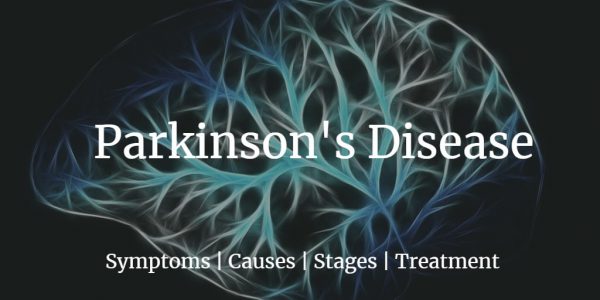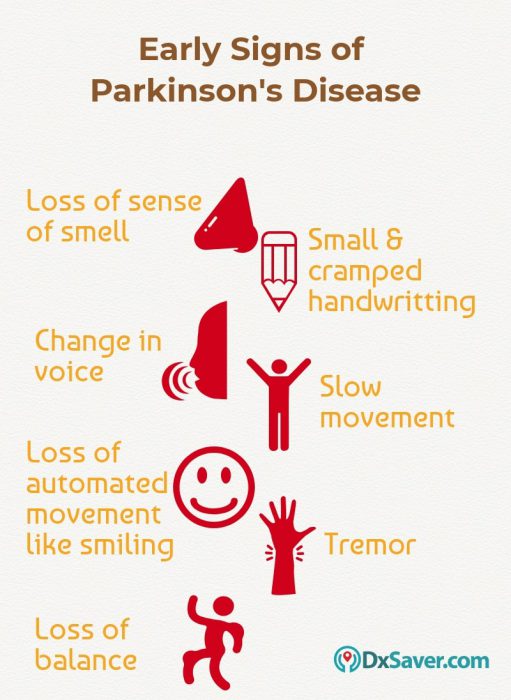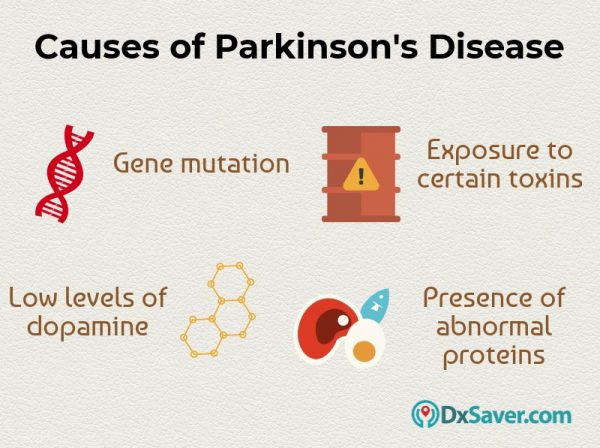
According to the Parkinson’s Foundation, nearly 60,000 people are diagnosed with Parkinson’s disease every year, and half a million people are living with this disease in the United States. It is the 14th major cause of death in the U.S. Research is ongoing to date to find a cure or a way to prevent this disease.
Read the article below to know more about the symptoms, stages, causes, diagnosis, and treatment of Parkinson’s disease.
What is Parkinson’s disease?
Parkinson’s disease is named after doctor James Parkinson who published a detailed essay called “An Essay on the Shaking Palsy”. This essay showed that Parkinson’s disease was a recognized medical condition.
Parkinson’s is the second most common progressive neurological disorder that affects the dopamine-producing neurons. Dopamine-producing nerve cells are present in the specific part of the brain called substantia nigra that controls the movement. Studies have shown that people who develop the symptoms of Parkinson’s do not have enough dopamine-producing neurons. Parkinson’s disease is chronic and it worsens over time.
Symptoms of Parkinson’s disease
In most cases, people above 60 years of age show the symptoms of Parkinson’s. When the symptoms are shown in people below 50 years of age, it is called “early-onset Parkinson’s disease”. The symptoms develop gradually, worsen over time, and may be different for each person. The early signs and other common symptoms of Parkinson’s disease are explained below.
Early signs of Parkinson’s
- Loss of sense of smell (anosmia)
- Constipation
- Voice changes
- Smaller and cramped handwriting
- Slow movements
- Loss of automatic movements like blinking and smiling
- Tremor
- Stiffness of legs and arms
- Gait (stooped posture)
- Problems with balance
- Rigid muscles
Early signs may go unnoticed or people might ignore them as if they are normal signs of aging. The symptoms can be controlled with proper medications and the life expectancy rate is higher if diagnosed and treated at the earlier stage. So we highly recommend getting tested when you recognize the above-mentioned symptoms.
Other common symptoms
- Blank facial expression
- Changes in the mood
- Depression
- Difficulty in chewing and swallowing
- Urination problems
- Skin problems
- Sleeping problems
- Dementia (loss of memory)
- Hallucinations
- Risk of developing skin cancer
- White or yellow scales on the oily parts of the skin

What are the stages of Parkinson’s disease?
There are many systems available for staging the Parkinson’s. But many doctors use the Hoehn and Yahr scale to classify the stages based on the symptoms. According to this scale, Parkinson’s has five stages.
Stage 1
At this stage, the symptoms are very mild and some people may not notice any symptoms. If the symptoms are shown, then they may be only on one side of the body.
Stage 2
Stage 2 may take years or months to progress from stage 1. During this stage, the symptoms worsen and are shown on both sides of the body. You may experience trembling, muscle stiffness, and changes in facial expression which might result in the delay of your daily activities.
Stage 3
This stage is the mid-stage of the disease. During this stage, all the symptoms are noticeable. You will experience slow movements, problems in balancing, and tendencies to fall. But still, people with stage 3 Parkinson’s can live on their own without much help.
Stage 4
During this stage, the symptoms are severe and people with Parkinson’s living on their own is very dangerous. They will need help with walking and for performing their daily activities.
Stage 5
This stage is the most advanced stage of Parkinson’s disease. At this stage, people with Parkinson’s will experience dementia, hallucinations, and confusion. They cannot walk and live on their own. So, full-time assistance is required.
How is Parkinson’s disease diagnosed?
There are no specific tests available to diagnose Parkinson’s disease. It is mostly diagnosed based on the patient’s health history, reviewing the signs and symptoms, and with a physical and neurological exam. Diagnosing Parkinson’s at the earliest stage is quite challenging as the symptoms of Parkinson’s are more similar to other movement disorders. A neurologist who is specialized in movement disorders can make the most accurate diagnosis.
Imaging tests like Magnetic Resonance Imaging (MRI), Computerized Axial Tomography (CAT), or Dopamine Transporter (DAT) scan will be performed to confirm the Parkinson’s and if not Parkinson’s, these tests can help the neurologist to rule out other disorders causing the symptoms.
What are the causes of Parkinson’s disease?
The cause of Parkinson’s is unknown but researchers say that these following factors can cause this disease.
- Gene mutations (if family members are affected by Parkinson’s)
- Environmental factors (exposure to certain toxins)
- Low levels of dopamine (Parkinson’s is related to movement)
- Low levels of norepinephrine
- Presence of Lewy bodies (the abnormal protein found in the people affected with Parkinson’s)
Researchers believe that the Lewy bodies present in the brain cells can hold an important clue to find out the cause of Parkinson’s.

Treatment for Parkinson’s disease
Parkinson’s disease can’t be cured but a combination of medications, therapies, and lifestyle changes can help the people affected with Parkinson’s to manage the symptoms.
Medications
The following drugs are used to treat Parkinson’s.
- Levodopa (helps to restore dopamine)
- Dopamine agonists (imitate the action of dopamine)
- Anticholinergics (helps with rigidity)
- Symmeteral (short-term relief for the side effect caused by Levodopa)
- Catechol O-methyltransferase (COMT) inhibitors (helps Levodopa to last long)
- Monoamine oxidase B (MAO B) inhibitors (helps to break down the dopamine in the brain)
Therapies
Speech therapy, occupational therapy, and physical therapy can help people affected with Parkinson’s to improve their communication and self-care.
Surgery
Surgeries are done only when the patient does not respond to any of the above-mentioned therapies and medications. Any of the following surgeries are performed to treat Parkinson’s.
- Deep brain stimulation (electrodes are implanted in specific parts of the brain to reduce the symptoms)
- The pump delivered therapy (a pump is placed near the small intestine to pump levodopa and carbidopa)
What are the risk factors and complications of Parkinson’s disease?
Though there is no exact cause found, researchers say that the following groups of people are at a higher risk of developing Parkinson’s disease.
- Men are more likely to get Parkinson’s than women.
- Whites are more likely to get Parkinson’s than African Americans or Asians.
- Exposure to certain toxins can increase the risk of getting Parkinson’s.
- Family history of having Parkinson’s
- People who come under the age group of 50 and 60 years
- People who experience severe head injuries
Complications of Parkinson’s disease
The following conditions are the severe complications of Parkinson’s and the side-effects of the medications that are used to treat Parkinson’s.
- Speaking
- Difficulty in chewing and swallowing
- Depression
- Anxiety
- Sexual dysfunction
- Sleeping problems
- Urinary problems
- Constipation
- Pain
- Blood pressure changes
- Dementia (loss of memory)
How to prevent Parkinson’s disease?
As the exact cause of Parkinson’s is not known, it is unclear how to prevent the disease. But researchers say that some of the following lifelong habits can reduce the risk of developing Parkinson’s disease.
- Turmeric (it contains curcumin which prevents the clumping of Lewy bodies)
- Flavonoids (antioxidants present in apple, berries, tea, and red grapes)
- Avoiding reheated edible oil (due to toxic chemicals)
- Aerobic exercise
- Antioxidants rich diet (anti-oxidants help in preventing the clumping of Lewy bodies)
If you have a family history of Parkinson’s disease, we recommend you to consider genetic testing as certain genes have been connected to Parkinson’s disease.
Other topics you may be interested in:-
- Herpes Symptoms in Men
- STD Testing Cost in Denver
- Symptoms of Gluten Intolerance
- Anti-Mullerian Hormone, AMH Test Cost in the U.S.
- How much does the Ovarian Cancer, CA – 125 Test Costs in the U.S?
- Cost of Cancer Tests in the U.S.
- STD Test Cost in Atlanta, Georgia
- STD Testing Cost in San Diego, California
- How Much Does At-Home Drug Test Kit Cost in the US?
- Luteinizing Hormone, LH Test Cost in the U.S.
- What is Lyme Disease?
- How Much Does the Ferritin Test Cost in the U.S?
- Cost of Cortisol Testing in the U.S.
- Is Bruising a Symptom of STD?
- At-Home Chlamydia Testing Cost in the US
- Types of STDs That Cause Skin Rashes on Genitals and Body
- Oral STDs: Names, Symptoms, Treatment and Testing Cost
- Causes of Penile Rashes and Other STD Symptoms in Men
- Symptoms of Gonorrhea, Causes, Transmission, Diagnosis & Treatment
- Importance of Hemoglobin A1C Normal Levels, Diagnosis & Treatment